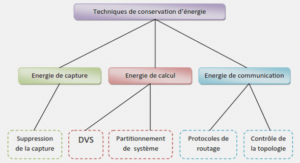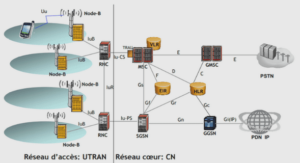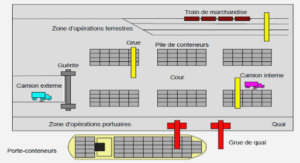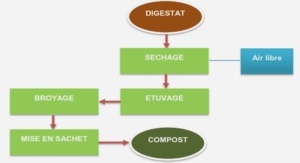OVERVIEW OF THE BODY AREA NETWORK
WBAN technology normalization
Efforts have been made to develop standards for the WBAN and an IEEE task group, IEEE 802.15.6 (IEEE 802.15.BAN), has been established for this purpose in November 2007.
This task group is the sixth task group of the IEEE 802.15 working group.
IEEE 802.15 is a working group of the Institute of Electrical and Electronics Engineers (IEEE) 802 standards committee which specifies Wireless Personal Area Network (WPAN) standards . It includes seven task groups and one interest group for Terahertz called IGTHz. In December 2011, the task group 802.1 5.6 or 802.1 5.BAN and task group 802.15.7 developed new standards for BAN and Visible Light Communication (VLC), respectively. IEEE 802.15.1, first published in June 2002, is a standard for WP AN based on Bluetooth, whereas, 802.15.2 pro vides recommendations for the coexistence of the WP ANs and Wireless Local Area Networks (WLAN). More details about other task groups of IEEE 802.15 are given on its website.
Antennas for WBAN channels
The 2.45GHz channel allows the use of smaller antennas, because the wavelength for this channel is in the range of few centimeters (about 12 cm). This advantage in the dimension cornes with complexity of the design for a WBAN channel. The requirements for antenna design at 2.45 GHz for WBAN applications could be summarized as follows.
A wearable antenna should be low profile, light weight and comfortable for the body surface . The antenna should have a high enough gain to offset the path loss that characterizes the WBAN channels, but not too high to be harmful. In fact, sorne antenna characteristics (such as the radiation patterns and gain) may change drastically in the presence of a high loss medium such as the human body.
In order to maximize coupling between body-worn deviees, the maximum of the radiation pattern should be tangential to the body’s surface ( creeping waves propagation) . However, in this case, the wave polarized parallel to the body will attenuate faster than the perpendicular polarized one . For off-body communication, the pattern must be directed away from the body. Omni-directional radiation pattern antennas (such as the monopole antenna) placed tangential to the surface of the body are generally considered suitable for on-body applications, when taking in consideration the gain reduction due to the presence of the body . For on-body applications, where the wave propagates along the surface of the body as creeping wave and is attenuated much more rapidly compared to the free space , the antenna must be designed for a minimum SAR. This could be achieved by by the use of a suitable ground plane of the antennas to re duce back radiation . Careful attention should be clone during the design to insure a low reflection coefficient at the desired frequency even when the antenna is mounted on the body, taking in consideration that detuning could occur in the presence of the human body.
Human body modeling and phantoms
Developing BAN systems in the GHz range may benefit from the development of experimental phantoms emulating the dielectric propetties of human skin in order to accurately characterize the on-body propagation channel; this requires an accurate estimation of the absorption of the electromagnetic power by the human body.
It is impmtant to know that the dielecttic properties of the human body are frequency dependent. Moreover, the penetration depth ofthe lower frequencies is higherthan that of the higher frequencies.Determining the dielectric properties of the human skin is the first step toward building a 2.45-GHz equivalent phantom. Three types of physical phantoms are presented in the literature, namely, the liquid, semisolid, and solid phantom . The three types differ upon complexity, frequency usage, and durability. Firstly, liquid phantoms are homogenous phantoms that representa convenient way to simulate the body. They are well suited for measurements in the 30-MHz-6-GHz range but cannot be used at millimeter range be cause of the Shell . Semisolid phantoms do not require any bounding container and have been used for antenna and on-body channel characterization ; They are especially useful to simulate organs with high water content like muscle and brain etc . Finally, solid or dry phantoms have the advantage of keeping their shape for a long period of time and have stable characteristics. The se phantoms can be built from a single organ phantom to whole body phantoms, depending upon the application.
MIMO channel
The limitations of SISO systems ( containing a single transmit antenna and a single antenna at the reception), due to the richness of multipath in a confined space such as a mine, have led researchers to consider alternative solutions in order to improve the capacity of the wireless systems. Renee, several studies have concluded that a system with multiple antennas at the transmission and at the reception takes advantage of the multipath to considerably improve the capacity ofthe radio link compared to a SISO system .
In fact, MIMO techniques are known to significantly improve the reliability of wireless systems by lowering the bit error rate (BER), improving the signal to noise ratio, and enhancing the capacity of the system. This could be achieved through diversity which proved to be powerful in lowering fading and improving the BER. Diversity provides the best results when the fading at the different branches is uncorrelated and the branch signais have the same average power . Usually, the higher order MIMO schemes are able to achieve the best performance in terms of BER. It was shown that a 4 x4 MIMO usmg space time codes, provide a better BER performance than a 2×2 or a 1 x 1 MIMO .
MIMO technology allows increasing the capacity of the wireless system without an increase in bandwidth. This increase in capacity is limited by the correlation and power imbalance among the spatial sub-channels, mutual coupling between the spatially separated antennas, and the presence of a strong direct link between the transmitter (Tx) and receiver (Rx) in the line-of-sight (LOS) transmission [34]. In an interesting on-body research, using two different models ofthree MIMO on-body channels each (using PIFA antennas), ergodic capacity performance has been examined in [35]. Results show that the belt head channel is comparable to a Rayleigh distribution, while the belt-chest exhibits a loss in MIMO capacity because of the presence of a strong LOS component .
Types of diversity
Diversity can be applied in several ways:
• Antenna diversity or space diversity, is a type of diversity that uses two or more antennas at the transmission or/and at the reception to improve the wireless link quality and reliability, by exploiting the multipath richness of the environment. It is mainly effective in urban and indoor environments where there is rarely a clear lineof-sight (LOS) . The multipath components usually exhibits phase shifts, time delays, attenuations, and distortions and can destructively interfere with one another at a receiver. Space diversity, because of its inherent multi-view of the received signal, is effective at mitigating these multipath issues. In fact, the signal will fade differently at each antenna. Thus if one antenna experience a deep fade, it is unlikely that the other antennas will behave in the same manner. Hence the overall performance of the link is improved .
• Time Diversity consists of sending the same amplitude samples at different time slots. When the time slots separation is high enough (at least the reciprocal of the fading bandwidth), the sequential amplitude samples ofthe fading signal will be uncorrelated.
• Frequency Diversity consists of transmitting the signal over several frequency channels with a separation that is necessarily greater than the coherence bandwidth.
• Pattern Diversity consists ofusing directional antennas at either at the transmitter or at the receiver (such as a bearn switching array). The radiation patterns are directed in different angles undergoing different fading, and hence uncorrelated; ideally the different patterns should have a minimum overlap and a combination of patterns similar to an Omni-directional pattern .
• Polarization diversity consists of transmitting and receiving multiple verswns of a signal through antennas having different polarizations. A difference between the polarized components received at the receiver usually called the cross-polarization discrimination (XPD), must be low for effective polarization diversity to get a high diversity gain .
Comparing the different types of diversity
This investigation showed that using spatial, polarization, or pattern diversity, diversity gains of 7-10 dB are achievable at the 99% probability level. Diversity gain of 8 to 9 dB is typical in NLOS indoor and outdoor channels using antenna spacings as small as 0.1–0.15/… The same research indicates that polarization diversity configurations can increase SNR by 12 dB or more in certain cases by eliminating polarization mismatch. In general, space diversity performs better than other types of diversities when the incoming angles of arrivai are uniform such as in the open surface communications. Space or pattern diversity outperform the polarization diversity in a situation where the transmitted wave is not heavily depolarized (such as the LOS situations) due to a high XPD . In NLOS scenario the performance of the polarization diversity is comparable to that of a space diversity . Polarization diversity has the advantage over space diversity in terms of economizing the cost because it can be designed using a single multi-polarization antenna, contrary to the space diversity .
|
Table des matières
CHAPITRE 1 :GENERAL INTRODUCTION
1.1) Introduction to the I’viaster Project
1.2) Problem
1.3) Objective ofthe research project
1.4) Research methodology
1.5) Thesis structure
1.6) Conclusion
CHAPTER 2 :OVERVIEW OF THE BODY AREA NETWORK
2.1) Wireless body area network (WBAN) technology overview
2.1.1) On-body technology
2.1.2) Off-body technology
2.1.3) On/Off-body technology
2.1.4) In-body technology
2.2) WBAN technology normalization
2.3) Antennas for WBAN channels
2.4) Human body modeling and phantoms
2.5) Conclusion
CHAPTER 3 :OVERVIEW OF .MIMO SYSTEMS
3.1) MlMO channel
3.2) MlMO matrix
3.3) Correlation of the branch signais
3.4) MMO channel capacity
3.5) Conclusion
CHAPTER 4 :DIVERSITY OVERVIEW
4.1) Types of diversity
4.2) Comparing the different types of diversity
4.3) Diversity gain
4.4) Conclusion
CHAPTER 5 :CHANNEL CHARACTERIZATION OVERVIEW
5.1) Large-scale channel characterization
5.2) Small-scale channel characterization
5.3) WBAN channel characterization
5.4) Phenomenon affecting radio signal propagation inside a mine
5.5) Channel parameters
5.5.1) Channel impulse response
5.5.2) Path loss
5.5.3) RMS delay spread and Coherence bandwidth
5.6) Different types of channel models
5.6.1) Deterministic modeling
5.6.2) Stochastic modeling
5.7) Conclusion
CHAPTER 6 :WBAN IN UNDERGROUND MNES
6.1) Measurement environment
6.2) Measurement campaign
6.2.1) On-body measurement procedure
6.2.2) Off-body measurement procedure
6.3) Measurement equipment
6.4) Conclusion
CHAPTER 7 :RESULTS AND ANALYSIS
7.1) On-body channel results
7.1.1) Channel impulse response
7.1.2) RMS delay spread and coherence bandwidth
7.1.3) Channel capacity
7.1.4) Dynamic Channel parameters’ Results
7.2) Off-body channel results
7.2.1) Channel impulse response
7.2.2) Path loss
7.2.3) RMS delay spread and coherence bandwidth
7.2.4) Channel capacity
7.3) Conclusion
CHAPTER 8 :GENERAL CONCLUSION
8.1) Conclusion
![]() Télécharger le rapport complet
Télécharger le rapport complet






